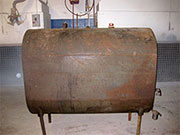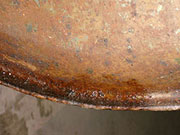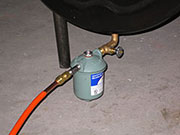Oil Tank Information
Indoor tanks
There are many configurations of indoor tanks available to fit the needs of different types of building structures; however the common one for residential use is the 275 gallon tank. This is an oval shaped tank that provides safe and economical indoor storage. Most towns allow for tandem installations, doubling capacity to 550 gallons. Double-walled tanks are also available and provide the added security of a double-wall containment system. Tanks are installed by licensed heating installers in accordance to current mechanical code guidelines. Tanks are inspected and tested to insure leak-free installations.
Above Ground Outdoor Tanks
Note: THE INSTALLATION OF HEATING OIL TANKS OUTDOORS OR IN UNCONDITIONED SPACES IS NOT RECOMMENDED. THIS INFORMATION IS PROVIDED IF A HOMEOWNER DOES NOT HAVE CONDITIONED SPACE AVAILABLE TO INSTALL AN OIL TANK.
Heating fuel begins to cloud (the fuel becomes opaque from the formation of small wax crystals) at about 20° above zero. In addition, high viscosity fuel caused by cold temperature has an adverse affect on burner performance causing the burner to run inefficiently and unreliably. We recommend piping with large diameter steel insulated fuel line (as opposed to small OD copper tubing), the use of a large capacity oil filter, and the installation of a fuel de-aeration device. Outdoor tanks should also be enclosed and insulated whenever possible. Bottom feed valves should never be used on outdoor oil tanks, or tanks in unconditioned spaces. Additionally, Patten Oil Company will only deliver kerosene to a tank in an unconditioned space.
Vent Alarms
Every oil tank should be equipped with a vent alarm system. This is a simple device installed inside your oil tank where air is vented. The vent alarm emits an audible whistle while the tank is being filled. When the oil level reaches (and covers) the bottom of the vent alarm, it stops whistling, there by alerting the delivery man that the tank is full.
Why do vent alarms malfunction?
On occasion, vent alarms may become obstructed with debris. When this happens, the oil delivery driver will not be able to safely fill your oil tank. When this happens, we will notify you immediately so the vent alarm can be repaired. Vent alarms can often be cleaned, but on occasion need to be replaced. Insects that build nests in vent pipes cause debris to fall into the vent alarm; however a more common failure is caused by rust build-up in the vent alarm. If an oil tank is old (20 + years) it may contain significant amounts of rust sediment. In this case, a new tank system may be recommended.
Underground Tanks
Contrary to popular belief, underground tanks can be installed provided certain guidelines are followed. The only tanks most towns generally allow are cathodically protected steel tanks, which are also referred to as STIP 3 Tanks. These tanks are treated with an epoxy resin coating and also provide cathodically protection via a zinc anode attached to the tank. Electrical leads attached to the zinc anode give the homeowner the facility to test the anode periodically to make sure that it is functioning. Fiber glass tanks are also allowed, although they are more costly and more difficult to install.
Tank Removal or Replacement
To address the needs of homeowners requiring fuel storage tank work, Patten Oil Company provides complete service and installation of all types of above ground residential and commercial storage systems. In addition, we provide comprehensive removal and tank disposal services.
Please call us for a quote today!
Good Tank...or Bad Tank?

A Bad tank. Notice the seeping along the bottom

A leaky seam
Many of our customers want to know-do I have a good tank, or should I look to replace my existing tank? There is no easy answer to this…an inspection by a qualified installer is the best approach.

A new, good quality tank.

A proper new line and filter
At right is a picture of a bad tank that has been seeping. Notice the line across the tank, up about a foot from the tank bottom. You can also see the seam that is leaking in the close up.
Tank legs rust, and lose their ability to hold the weight of a full tank (250 gallons of fuel is approximately one ton of fuel)! Tanks that sit in damp basements are particularly susceptible to rusting.
Old lines and filters are another big problem-one that shouldn’t wait. A fuel line that “let’s go” can spill a great amount of fuel into your home quickly. Take a look at the proper line/filter installation at bottom left. This includes a Fire-O-Matic Safety Shutoff Valve that is now required by the State.
Finally, look closely at the new tank at top left. Note the rounded edges on a newer tank....one quick way to tell if your tank is old, and at risk of developing a leaky seem is having a tank that does not look like this.
Don’t wait until after you’ve developed a leak to have your tank inspected……..the cost to clean a fuel spill far exceeds the cost of a new tank and supply line!